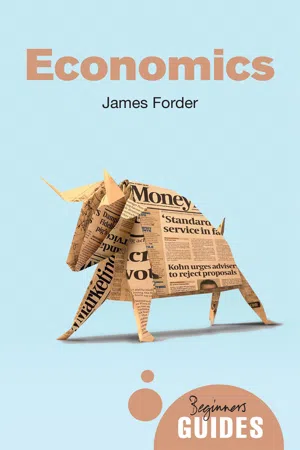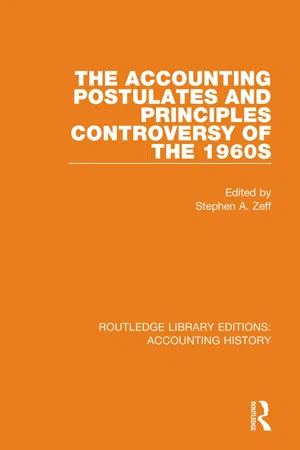Economics
Unit of Account
A unit of account is a standard unit in which prices and costs are quoted and recorded. It provides a common measure for comparing the value of different goods and services. In economics, it serves as a way to facilitate trade and economic transactions by providing a consistent means of expressing value.
Written by Perlego with AI-assistance
Related key terms
4 Key excerpts on "Unit of Account"
- eBook - ePub
Economics
A Beginner's Guide
- James Forder(Author)
- 2016(Publication Date)
- Oneworld Publications(Publisher)
‘Unit of Account’ means the measuring rod of economic value – the units in which prices are quoted. A ‘medium of exchange’ (or ‘transactions medium’) is the device commonly used to make payments, and a ‘store of value’ is a way of taking the power to make purchases that we have today, and moving that power to purchase into the future. But those are the functions of money – they are what money does. They do not exactly tell us what money is, or how to define ‘money’. That point perhaps comes out clearly if we consider that all the functions of money might be performed by things we would not call ‘money’. The most obvious is the last of them – many things can be used as a store of value: stocks and shares, wine, land, a pile of bricks. Indeed, in principle, anything that is durable and saleable might be used to store value. Some would be better stores of value than others, of course. But that point draws attention to the fact that some of them might be better stores of value than money – in conditions of inflation, it might well make more sense to buy a house than to keep money, just to keep wealth intact. Similarly, the Unit of Account could be almost anything. It would not be impossible to list prices in terms of some commodity, whilst making payments in dollars and pounds. We could, for example, imagine the case where prices were quoted in kilos of salt. So, the price of a pint of milk might be three and a half kilos of salt, or the price of a car 30,000. In that case, salt would be the Unit of Account, even if salt was never handed over in making a payment. In a few odd cases, something like that does actually happen – the British practice of pricing racehorses in ‘guineas’, each equal to £1.05, is an example. Here, guineas are the Unit of Account, although pounds are the medium of exchange. And money as a medium of exchange is certainly not absolutely necessary. We know that from the fact that sometimes it is not used. Sometimes, we do swap goods for goods - Stephen A. Zeff, Stephen A. Zeff(Authors)
- 2020(Publication Date)
- Routledge(Publisher)
Money is used both as a medium of exchange (debt-paying medium) and as measure of exchangeability or “standard of value.” The first of these characteristics specifies the type of economic system we are most interested in—one in which money is used almost universally to pay wages and taxes and generally to discharge debts. Except, however, for characterizing the kind of economic organization—the “money economy”—in which accounting flourishes, this first characteristic is not of much significance. Accounts can be and are kept in the absence of any “money” (cash on hand or in bank, legal tender or its close substitutes).2 W. B. McFarland, “Research in management accounting by the National Association of Accountants,” Accounting Review, Jan. 1961, pp. 21-25.It is the second characteristic that is crucial for accounting. Accounting involves measurement; in order to measure, a unit common to all objects to be measured is needed; in an “exchange economy” the only measure common to all objects that do or can enter into the exchange process is their exchangeability or “value in exchange.” And this measurement is expressed in terms of money in its function as a common denominator or standard of value, with “value” meaning “value in exchange.” This use by accounting of money as a common denominator is merely a specific example of the logical requirement that two or more objects must be expressed in identical units before we can perform operations on them, such as adding them together, or subtracting one from the other. Emphasis on this logical requirement leads naturally to a question as to whether the use of the monetary unit in current use does in fact express all the objects in terms of a common unit. Almost universally, in the past as well as the present, the “money of account” in use is the local currency of the country in which the accounting entity is located. But the variability of all local currencies is notorious. Later we will have to face the problem of deciding whether or not the dollar, or pound, or franc is in fact the best measuring unit available in the United States, or England, or France. For the present, the point of agreement is that money is used almost universally as the common denominator in economic and business affairs and, hence, in accounting.- eBook - ePub
- John Smithin(Author)
- 2008(Publication Date)
- Routledge(Publisher)
In the classical economic sociology literature it was also Weber (1978, 2003) who made the arguments that a money of account is the prerequisite for rational accounting, the publication of price lists and financial results, and for the calculation of profit and loss generally. This view was also shared by the economist Keynes (1930, 3) who says quite clearly and unequivocally that “[m]oney-of-account … is the primary concept of a theory of money”. Ingham (2004, 21–3) explains that “money of account makes possible prices and debt contracts … money accounting, with or without an actual ‘money stuff’, is the means by which modern market exchange is made possible … producing action at both spatial and temporal distance”. In other words, for business operations to be conceivable at all there must be some mechanism whereby payments actually can be made, and profits can be realized in some socially objective form, not reducible to subjective private utilities.Money as a Unit of Account and means of payment
Dow and Smithin (1999), drawing on Hicks (1989), further identify an important element of a monetary economy as the existence of a unique ultimate or final monetary asset in which the twin functions of the Unit of Account, just discussed, and means of (final) payment are actually combined.4 Contrary to suggestions made in the “new monetary economics” (NME) literature of the 1980s (Fama 1980), these two specific functions are inseparable. The NME literature, though, tended to confuse this issue by talking mainly about the separation of functions at the level of the medium of exchange, again showing the influence of the standard barter exchange theory (Smithin 2003a). This idea of an ultimate monetary asset corresponds to what is known as base money in mainstream literature or valuata money - eBook - ePub
- Shahzavar Karimzadi(Author)
- 2012(Publication Date)
- Routledge(Publisher)
The principal reason given for the Unit of Account function of money is that “it assumes the existence of customary ratios” (Coulborn 1938: 27). J. M. Keynes (1883–1946) was one of the most prominent adherents of the unit account function of money as the source of its origin. The irony is that although Keynes elevated the role of money to its highest position in contemporary economies, he failed to provide a coherent argument about its origin. He presented three different versions of the same theory. One of these three versions is the Unit of Account theory of the origin of money. His starting point for this version of the origin of money is the barter exchange. But his barter system comes with one major difference. The specific characteristic of barter exchange in this case is not the lack of a medium of exchange. In this instance there is a medium of exchange but the economic system nevertheless operates on barter exchange. Not only that, but the economy remains moneyless. For Keynes the transformation of a medium of exchange to money occurs at the point in time when debts and prices are expressed in terms of money of account. This is the precedence of the money of account in order of time to the medium of exchange that determines the source of the origin of money. In volume 1 of his Treatise on Money, this is how he describes the formation of money from its function as a Unit of Account: Money itself, namely that by delivery of which debt-contracts and price- contracts are discharged, and in the shape of which a store of General Purchasing Power is held, derives its character from its relationship to the Money-of-Account, since the debts and prices must first have been expressed in terms of the latter. Something which is merely used as a convenient medium of exchange on the spot may approach to being Money, inasmuch as it may represent a means of holding General Purchasing Power. But if this is all, we have scarcely emerged from the stage of barter
Index pages curate the most relevant extracts from our library of academic textbooks. They’ve been created using an in-house natural language model (NLM), each adding context and meaning to key research topics.



